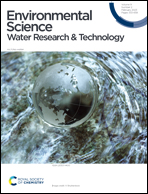Insight into the corrosion inhibition of the iron anode with electro-deposited polyaniline during the electrocoagulation treatment process of electroplating wastewater†
Abstract
In this study, polyaniline (PANI) and polypyrrole (PPy) coatings were applied to modify iron plate anodes to treat electroplating wastewater by electrocoagulation (EC) treatment. Firstly, FT-IR, SEM and EDX characterization proved the successful coating with PPy–PTS (p-toluene-sulfonate) and PANI–MMT (montmorillonite). Secondly, the electrochemical behavior indicated that PANI–MMT has better corrosion resistance, protective layer, and gas–liquid barrier ability than PPy–PTS. Thirdly, the removal efficiencies of zinc (Zn) and nickel (Ni) within electroplating wastewater reached 98.4% and 80.7% for the PANI–MMT coated anode under optimized EC operating conditions, namely an operating time of 100 min, an initial pH of 7 and a current density of 20 mA cm−2, while those of the PPy–PTS coated anode reached 96.5% and 78% respectively. Moreover, the results indicated that the corrosion inhibition efficiency of the PANI–MMT coated iron plate anode was about 35% even after 10 repeated EC treatment processes, nearly 5% higher than that of the PPy–PTS coated anode. Finally, the negative adsorption energy of the PANI–MMT coated anode reached a minimum of −183.59 kJ mol−1 compared to −169.42 kJ mol−1 for the PPy–PTS coated anode. Therefore, the PANI–MMT modified iron anode could achieve better plate protection and higher heavy metal removal efficiency as well, effectively extending the service life of the iron plate and reducing the operating cost.



 Please wait while we load your content...
Please wait while we load your content...